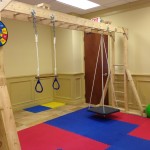Occupational Therapy
What is Occupational Therapy?
Occupational Therapy is a service that helps people learn to do things by themselves. Pediatric occupational therapists teach skills through play to help children meet milestones, become school-ready, and learn to take care of themselves. The following is a brief overview of the areas that can be helped by occupational therapy.
Motor milestones – the major stages of muscle movements and coordination that indicate progress in motor development.
- Gross Motor- larger movement patterns using arms, legs, and trunk. Improving this skill involves consistent coordination of the entire body while remaining stable.
- Fine Motor- smaller movement patterns. Improving this skill involves careful coordination of small muscle movements of the hands.
Visual-Motor Integration – (also referred to as eye-hand coordination) works on using hands and eyes together. The eyes guide the movements of the hand to complete intentional, smooth movements
ADLs (Self-care skills) – the daily activities we do to take care for ourselves to keep us safe and healthy. Examples include: dressing, feeding, tooth brushing, grooming.
Emotional Regulation – the ability to control our emotions in order to maintain socially accepted behaviors. This also involves the ability to understand what others around us are feeling and knowing how to act in response (Emotional Intelligence). This treatment is particularly helpful for children who have frequent tantrums and difficulty with transitions or changes to routines.
Community Integration – the ability to participate within the community with others. Treatments involve skill sets like mobility, safety awareness, problem-solving, going into public places.
Life Skills – more advanced skills that allow individuals to perform tasks without immediate supervision. Examples include: tidying a room, preparing simple snacks, vacuuming, laundry.
Attention – the ability to focus on what is important and ignore what is not important. There are many types of attention: selective, divided, sustained, alternating, visual, etc. Treatment focuses learning how to tell if something is important or not.
Assistive Technology and Adaptations – assistive technology is any equipment that helps us adapt a task in such a way that we can do it more independently.
Play skills – The basic skills which set the way for all human interactions. Children’s primary occupation is play and some children require extra assistance to learn play exploration, rules, and creativity. Children learn best through play.
Social skills – the skills we need to be able to communicate and interact with one another effectively. Treatment involves helping children understand social cues and how to respond to situations.
Handwriting – The skill of using a utensil to write letters which is the basis of written communication. Handwriting is a necessary skill for academic achievement. Some children have difficulty with legible writing and require additional support from occupational therapists to improve grasp on the pencil, letter formation, force, and legibility.
Musculoskeletal (the muscle and bone systems) – treatment involves improving range-of-motion (ROM), flexibility, muscle strength and endurance.
Coordination – the body’s ability to plan and perform movements in a controlled manner. Treatments assist children in learning body awareness to prevent clumsiness as well as learn how to use body parts together in a meaningful manner.
Executive Functioning – mental control and functioning. Executive functioning is a large skill set that encompasses: problem-solving, motor planning, judgement, safety awareness, and self-regulation.
Feeding/Eating – the skill of manipulating multi-textured foods within the mouth and tolerating a balanced diet. Treatments involve strengthening the mouth, improving control of food within the mouth, and tolerating various textures and foods.
Sensory Processing – the ability to understand what is going on within an environment and preparing an appropriate response. Children who have difficulty with sensory processing develop inappropriate behaviors in response to environmental changes/stimulation. Treatments focus on learning threatening and non-threatening stimuli, learning strategies to cope with non-preferred stimuli, and regulating the sensory system for improved participation in the environment.

